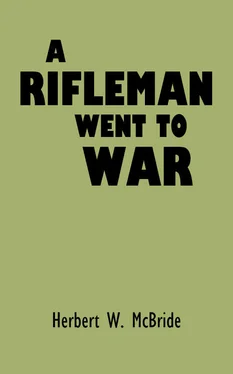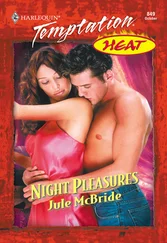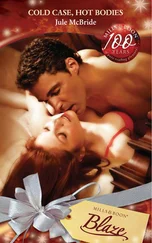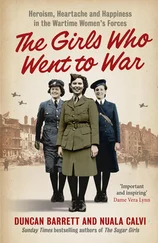The same thing applies to the “popular” war stories and pictures. In cases where these stories and pictures are from the pens of men who actually served as soldiers, the authors know full well that they are ridiculously exaggerated and distorted, but they also know that the plain, unvarnished truth would not be accepted by the public or, what is more important to them, by the publishers, so they proceed to manufacture thrills to order. This I have not done.
Closely akin to this situation is the idea, prevalent among the populace of the United States at large, that the nation is safely and sufficiently protected because, in the event of foreign invasion or aggression, millions of men would immediately “spring to arms,” as the late Mr. Bryan expressed it. Even with the disastrous example of the last war still fresh, they just cannot or will not accept the truth that the ordinary citizen cannot be made into a trained soldier by the simple expedient of placing a weapon in his hands. Soldiers themselves; those who have “gone through the mill,” know all about it, but who pays much attention to a soldier — in time of peace? It’s Kipling’s “Tommy Atkins” all over again:
“Oh, it’s Tommy this and Tommy that,
And Tommy go away.
But it’s ‘Thank you, Mister Atkins,’
When the Band begins to play.”
* * *
Probably no other single thing in the soldiering game is so little understood as rifle shooting. The general impression seems to be that all that is necessary is to give a man a rifle and some cartridges and that, in some miraculous way, that man immediately becomes a perfectly good and competent rifleman, able to knock over any number of the enemy at most any range.
WE know: Those of us who have spent years and years trying to learn the game — but how are we going to pound it into the head of “the man in the street”? This writer grew up in a family of shooting men — and good ones too — and kept up his training, all the time, winter and summer, throughout the years, yet he was well past thirty before he really learned much about real, honest-to-goodness military rifle shooting and it took a long period of intensive training, under the best of instructors and in the stiffest of competitions before he felt that he was really entitled to be called a “rifleman.”
The above is written as a partial answer to numerous queries, received from correspondents all over the country, as to whether I thought all the training and range firing and the annual competitions at Camp Perry were “worth while.” The answer, most emphatically, is yes: not only worth while; they are absolutely essential for the proper training of military riflemen. Without the intimate knowledge of weapons, ammunition and weather conditions which can be gained in no other way, there would be no real riflemen. Every bit of information that may be picked up on the range will prove useful in war. True, it will not always — nor often — be possible to assume the exact, orthodox positions used in competitions and there is the matter of adjusting oneself — mentally and physically — to the stress and strain of battle but, just the same, all those fundamental principles will have an important, even if sub-conscious influence, tending to increase the rifleman’s effectiveness.
All the “rifle cranks” in this country are helping the cause. Their ceaseless experiments in reloading, devising new cartridges and components and designing new bullets, sights and various other mechanical improvements; their indefatigable industry in trying out everything new, both on the target range and in the hunting field; all are of incalculable value to the military rifle game. And of special value are the great National Rifle Competitions, held annually at Camp Perry, and similar meetings. Without such men, doing these things, and particularly without the continuous efforts of their splendid organization — the National Rifle Association — we would soon find ourselves far behind in the big parade of progressive nations insofar as military preparedness is concerned. And it is for these men that I have really written this narrative.
Herbert W. McBride,
Indianapolis, Indiana
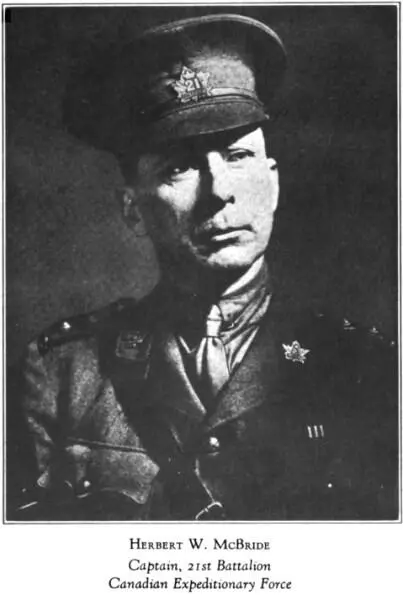
AS THIS is the story of an alleged rifleman, I suppose it is fitting that I offer some evidence to support the allegation.
My experience in this line really began some fifty-odd years ago when, as a little boy, I used to sit and watch my father get his outfit ready for the annual deer hunt. We lived up in the Northeastern corner of Indiana and the hunting ground, at that time, was just a few miles out of Saginaw, Michigan. Father had two boxes, which he had made himself. One of them contained the cooking outfit — everything from reflector oven to knives, forks and spoons — all especially made to nest and fit in the chest. The other, smaller than the first, carried his guns and all the accessories. In those days you “loaded your own” so, besides the usual cleaning tools, oils and so on, there were plentiful supplies of powder, both rifle and shotgun, shot, bullet moulds, cartridge cases, both for the rifle and shotgun and all of brass (that was before the advent of the paper shotgun cartridge case), primers and a goodly supply of lead. Of course, at the start, he had a plentiful supply of loaded cartridges for both guns. At first, his deer rifle was a single shot Remington, .44 calibre, rimfire. He later had it bored out to take the .45-70 U.S. Government cartridge.
For weeks before the time of departure for the hunting grounds, the crowd would get together every few days and pull off a shooting match, each one trying some new idea he had worked out since the last expedition. It was nothing unusual for half the merchants of the little town to shut up shop in the middle of the afternoon and, together with the lawyers, doctors and, yes, the preachers, to repair to some vacant lot and shoot impromptu matches with everything from old “pepper-boxes” to the latest rifles at that time available. At that time and in that place, practically all of the “men” were veterans of the Civil War and this shooting business was part of their gospel. Naturally, as a young boy, I became infected, and my father, believing in the idea of preparedness, gave me ample opportunities to learn the game; even to letting me shoot his heavy guns when he knew very well they would kick the stuffing out of me. He was a good and kindly man but he had no use for mollycoddles.
From time to time he bought me rifles, beginning with the little old Flobert; then a Quackenbush. Well, anyway, I remember that last one, with its heavy, round, nickel-plated barrel. When I was about twelve he had the local gunsmith make me up a real rifle: a muzzle loading Kentucky squirrel rifle with the barrel cut down to thirty inches and the stock likewise trimmed down to what we would nowadays call “sporter” proportions. I still have that rifle and while it looks like — well — not very much, when I was using it, it certainly delivered the goods. A hawk on a snag anywhere within one hundred yards or a woodpecker on the highest limb was certainly out of luck and the squirrel that was foolish enough to stick his head over the limb was just as good as in the pot.
I made my own powder-hom and bullet-pouch and, of course made my own bullets. The caps — “Elys” — I had to buy, as I did the powder and lead, with what money I could earn by odd jobs, one of which was the catching of rats around our premises. Father gave me five cents apiece for every rat.
Читать дальше
